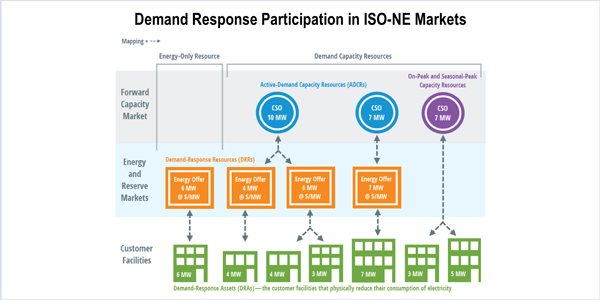By Michael Kuser
ISO-NE said last week it has become the first U.S. grid operator to put demand response into its energy dispatch along with generating resources.
The RTO’s price-responsive demand (PRD) structure, which took effect June 1, enables full integration of DR into its energy, reserves and capacity markets.
Like generators, active DR is now eligible to submit day-ahead and real-time energy offers and receive wholesale market payments for energy, operating reserves and capacity. DR resources can be co-optimized in the RTO’s economic dispatch, committed by the RTO a day ahead and dispatched in real time.
“The new thing is that active demand response resources can participate by submitting price and amount offers in the day-ahead and real-time energy markets, and they can set price,” said ISO-NE spokeswoman Marcia Blomberg.
Modest Impact
Blomberg said the impact of the changes on the markets has been modest thus far.
“On several hours on several days, we’ve seen small amounts [of DR] clearing,” she said of the RTO’s experience since the beginning of the month. “On other days, no DR cleared.”
Active DR resources are dispatchable because they can reduce consumption at will by reducing industrial production or switching to on-site generators or storage. Passive DR — energy efficiency and distributed solar generation, for example — are not dispatchable.
Active DR was previously able to offer load reductions at a price in the day-ahead energy market, but their offers were administratively evaluated after the market had cleared. DR offers were not used to determine the optimal dispatch of resources or to set price.
Both active and passive DR have been able to participate in the capacity market since 2006. Participating DR was dispatched only during grid emergencies, Blomberg said.
In March 2011, FERC Order 745 required RTOs/ISOs to pay active demand resources the market price for helping to balance real-time supply and demand.
‘Enormous Project’
Integrating active DR into the markets “has been an enormous project, requiring the ISO to not only develop and implement extensive market rule changes, but to update computer systems and processes related to grid operations and market settlement,” Henry Yoshimura, director of demand resource strategy, explained in the RTO’s newsletter. “Consequently, the full integration of active demand resources was achieved in a staged approach.”
Facilities that reduce their consumption of electricity are known as demand response assets (DRAs). DRAs under 5 MW can be mapped to a DR resource that participates in the energy and reserve markets. A DRA that is 5 MW or larger must participate individually as its own resource.
DR resources can be mapped to an active demand capacity resource (ADCR) for participation in the capacity market. Passive DR resources may only participate in the capacity market.




